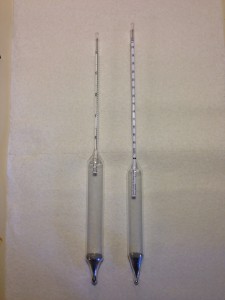 So let’s say that you’ve collected your wort, measured the wort volume and pre-boil specific gravity and, and used the “CV” equation to estimate your OG. And . . . you’re going to come in low. What do you do now? You have three main options.
So let’s say that you’ve collected your wort, measured the wort volume and pre-boil specific gravity and, and used the “CV” equation to estimate your OG. And . . . you’re going to come in low. What do you do now? You have three main options.
Let It Go
Although we’d all like it if everything went perfectly every brewday, things happen. In some cases, it pays to consider whether the problem needs to be remedied or if it can be tolerated. In the case of a low OG, your beer isn’t going to turn out as planned. However, if everything else goes fine, the beer’s quality should be fine. So one consideration — especially if you’ve only slightly missed the mark — is to just let it be and continue on with your brewday.
Fix It
On the other hand, if you want to fix the problem, it’s not that difficult. The easiest option is to add malt extract to make up the deficit. Many all-grain brewers keep a bag of dried malt extract handy, for yeast starters mostly. If you take your projected post-boil volume and specific gravity, you can calculate how much malt extract to add.
For example, let’s say you collect 6.5 gallons of wort at SG 1.044, for a 5.0-gallon batch of stout. (I’m going to work the problem in English units, but it works just the same if you use liters instead of gallons.) Using the CV = CV equation, your predicted post-boil specific gravity is 1.057. However, let’s say your expected OG was 1.065 and you really want to hit that gravity. One way to correct this would be to add sufficient malt extract to cover the shortfall.
Dried malt extract yields 45 point gallons per pound (pg/lb. — also referred to as points per pound per gallon). This means that a pound of malt extract in a 1.0-gallon solution has a specific gravity of 1.045 (or 45 “points”). If you subtract your expected OG from your estimated OG — 65-57, in “points” — you get 8 points short in your 5.0 gallons of stout. Multiplying the point deficit by the volume (in gallons) gives you the deficit in point gallons. In this case, 8*5 = 40.
Now you have 40 point gallons to make up and dried malt extract yields 45 pg/lb., so divide 40 by 45 to get the amount of dried extract (in pounds) to add. (40 pg divided by 45pg/lb. = 0.89 lb.)
You can use liquid malt extract, which typically yields 37 pg/lb. (sometimes less). You can also use can cane sugar (sucrose, 45 pg/lb.) or corn sugar (glucose monohydrate 37 pg/lb.). However, the last two are 100% fermentable, unlike malt extract, and will yield a dried beer.
The metric equivalents are 375 point liters per kilogram (pL/kg) for dried malt extract (and acne sugar) and 308 pL/kg for liquid malt extract (and corn sugar).
Boil Longer
If you don’t have malt extract handy, or don’t want to add malt extract, you can always reduce the volume of your wort until you hit your target OG. If you do this, however, you need to make some compensating changes to your hop additions. Specifically, you’ll need to reduce your hop additions to account for the lower wort volume.
In the example above, the post boil volume was estimated to the 1.057 out of an expected 1.065. To reach an SG of 1.065 by boiling, the brewer would have to boil the wort to:
57p/g(5.0g) = 65p/g(Xg)
X = 4.38
So, the brewer would have to boil his wort down to 4.38 gallons to yield an OG of 1.065.
Boiling the wort to reduce the volume further than initially planned means extending the boil and shifting the hop additions forward so they will fall the same distance from the end of the boil. And, the amount of hops will need to be reduced to account for the reduced volume. To reduce the hop amounts proportionally, take the actual final volume divided by the planned volume, and multiply the hop amounts by this fraction. In our example, we would multiply each hop amount by 4.38/5.00. If the beer has other flavors added, these should scaled proportionally, too. Extending the boil may result in slightly darker beer, but the difference should be small unless the wort gets scorched.
Tomorrow, I’ll discuss what to do if you overshoot your OG.
—
Related Articles

Speak Your Mind